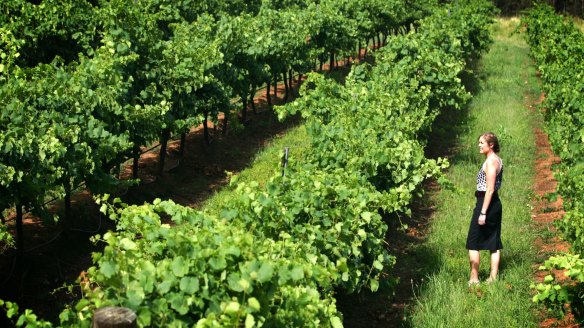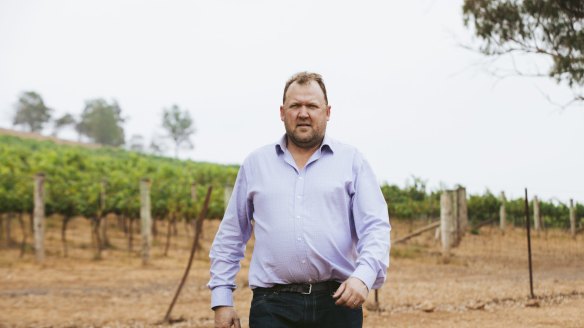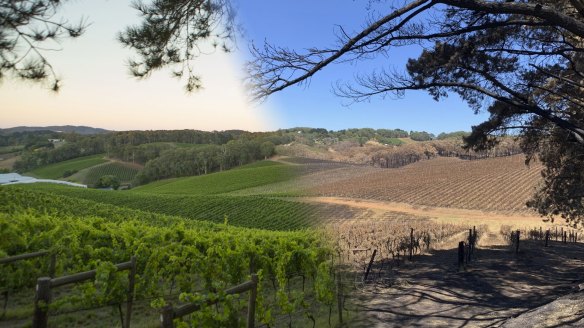Australian wineries hit by triple whammy of drought, fires and tourism decline

To harvest or not to harvest? That is the question hundreds of Australian wine producers will ask in the next couple of weeks, as the results of widespread smoke taint tests come back in record-breaking numbers. Much larger than anticipated readings are a blow to the wine industry, coming off the back of a long drought and reduced visitor numbers.
Wine producers are used to the peaks and troughs that come with farming: locusts, hails, frosts, droughts and water shortages. But rarely smoke taint – where exposure to smoke gives wine an ashy, burnt or medicinal taste, something that is only discovered in the fermentation process.
Australia is a world leader in smoke taint research and identification, but the summer bushfires are unprecedented – extensive, long-lasting, early and very close to grape-ripening periods. Experts are still trying to work out the extent of the damage.

The Hunter Valley is one of the worst affected. Tyrrells has lost 80 per cent of this year's vintage ("any wine that we do bottle from the 2020 vintage will only be of a standard that the family deem befitting of our 162-year legacy", Bruce Tyrrell said in a statement); neither McWilliams nor Mount Pleasant will pick grapes, and Brokenwood and Tulloch have written off most of their crops.
Australia's biggest winery group, Treasury Wine Estates, which includes Penfolds, Wolf Blass, Seppelt and Lindeman's, is also likely to be affected.
Tulloch Wines chief executive and president of the Hunter Valley Wine and Tourism Association, Christina Tulloch, says the smoke taint results have hit hard, coming after drought, water shortages and reduced tourism numbers, with an estimated $42 million wiped from the visitor economy from November to January.
I wouldn't be surprised if we see some interesting things to come out of this vintage.Christina Tulloch, Tulloch Wines
"It has been a triple whammy and now it is rounded out with a bit of coronavirus – our numbers are now showing a big reduction in forward bookings for tourism and conferences," she says.
NSW Wine Industry Association executive officer Angus Barnes says every wine region in NSW is being tested for smoke taint, and estimates are a drop of up to 30 per cent in the already drought-affected 2020 wine production. It will mean losses of more than $100 million, as well as decreased availability of wines – and medal-winners.
Besides the Hunter Valley, Tumbarumba, Mudgee, Orange, Shoalhaven, Gundagai, Griffith, Cowra and Canberra are all likely to show effects. "When I first started the process, I was very optimistic and tried to paint a positive picture," Barnes says. "But I now think we have to be more realistic and there will be an impact. I can no longer say that certain regions will be free of smoke. 2020 will go down as a very bad year for wine."

In South Australia's Adelaide Hills, about 30 per cent – or 1100 hectares – of vines have been lost to fire, affecting 60 growers and winemakers. These include big names such as Henschke, Hardys Wines, Tilbrook Estate, Bird in Hand and Petaluma. Smoke damage remains a big issue although Kerry Treuel, executive officer of the Adelaide Hills Wine Region, hopes the later harvest and the fire's sporadic nature may save some vintages.
Kangaroo Island lost crops to fire and is also affected by smoke taint.
In Victoria's north-east, wineries in Beechworth, the King Valley and Rutherglen have experienced smoke taint damage, as has Gippsland in the south.
But, according to the Australian Wine Research Institute, which conducts most of the testing, even neighbouring vineyards can yield very different results to testing.
Distance from the fires; vineyard elevation and topography,, weather conditions, how close the grapes were to ripening and even the variety – verdelho grapes do not seem to be as susceptible as semillon – are all factors affecting the extent of smoke taint.
Then there is this outlier: AWRI blind tests with experienced wine judges, but past results have shown that 20 per cent of tasters could not discern anything smoky about the wines, while others found the wine undrinkable.
"This is new territory for us – it may be one of those things where some people don't notice a smoke taste in the wine," Wine Australia's Anita Poddar says. "For seasons, winemakers have been dealing with these decisions, it's just that now it's a bigger cohort of people."
In many cases, the ruined grapes will be harvested and used for mulch and crop feed and, as in the case of Tulloch Wines, experimental fermentation.
Christina Tulloch is looking forward to what they can learn for future winemaking.
"I wouldn't be surprised if we see some interesting things to come out of this vintage," she says. "And it will be good to see people having a go. Let them make up their mind about what they think is different or interesting. We've had orange wines, natural wines, possibly now smoky wines. If life gives you lemons, make lemonade."
Tony Battaglene, chief executive of Australian Grape and Wine, backs this up by pointing out winemaker Brian Croser rated an early 1970s Hunter Valley wine as one of the best he had tasted, despite the year being written off as too smoke-affected.
Either way, Tulloch is confident Australia's oldest wine-making region will survive and thrive. "This is a new one that we haven't seen before but we are resilient and we will get through it. We always do."
What's to love
"We've been blessed. We've just opened back up and so many people have been so helpful."
These are unexpectedly positive words from Cathy Gairn, of the much-awarded Courabyra Wines in Tumbarumba. Cathy and husband Brian lost 15 per cent of their 28-year-old vines in a New Year's Eve fire that saw many vineyards burned to the ground or ruined by fire retardant.
When they evacuated – surrounded by flame on both sides – they assumed they had lost everything. They later learned that two neighbours had stayed behind and saved their house, cellar door and some vines. Nearby homes, and the blueberry farm behind them, were destroyed.
They are waiting on final results of smoke taint testing but are not expecting to salvage any of the 2020 vintage. "We are not likely to harvest," Cathy says. "So we will run out of some varieties and we are prioritising where we are selling."
If there is a silver lining, it's in the humanity that surrounds them. The truckload of wire and posts that turned up unannounced from Moama, four hours inland; the 16 army guys who pulled down their burned fences, which eight BlazeAid volunteers are now rebuilding for them; the diner who overheard guests mention losing their home, and quietly paid for their meal.
"It's amazing, the generosity of people," she says.
At nearby Johansen Wines, a campaign to sponsor one of the 3500 vineyard posts that need replacing is helping them rebuild. And tickets to next week's annual Tumbafest (February 22-23), for which headliner Kate Ceberano donated her fee, have been selling well, with some communities fundraising to purchase bulk tickets.
In other regions, preparations for end-of-harvest celebrations from March to May are under way, with grassroot campaigns such as #emptyesky and government initiatives such as SA's #BookThemOut aiming to increase visitation.
It's these types of ideas that will see Australian winemakers through, says Tony Battaglene. "The public response has been overwhelming; a lot of the wine producers are very embarrassed about it. But they are over the moon."
He urged consumers to keep supporting their local wines – often excellent employers in regional areas – even after the fire news has died down.